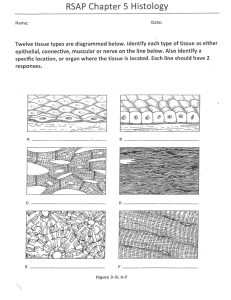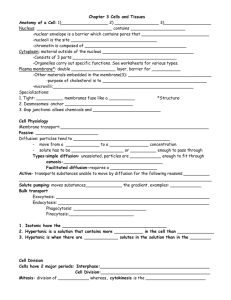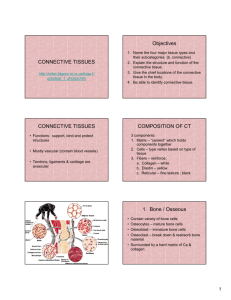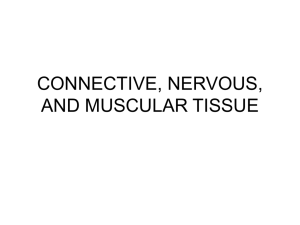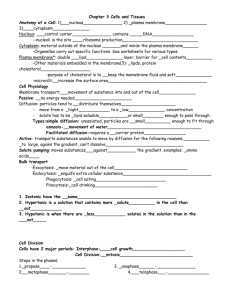Chapter 5: CONNECTIVE TISSUE
advertisement
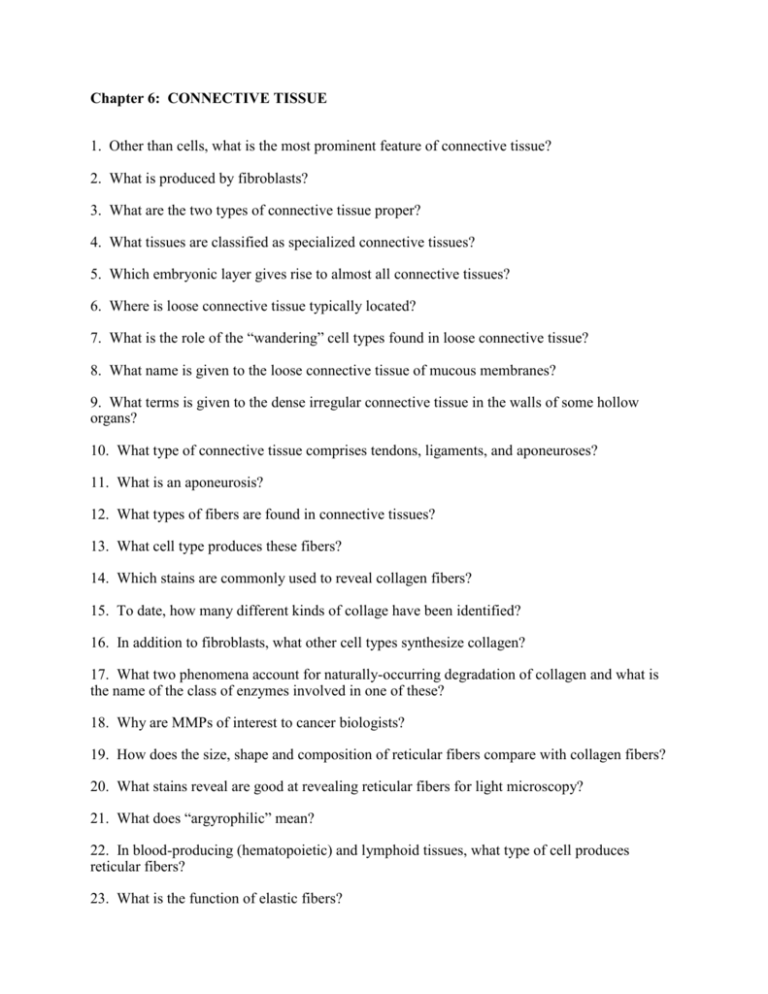
Chapter 6: CONNECTIVE TISSUE 1. Other than cells, what is the most prominent feature of connective tissue? 2. What is produced by fibroblasts? 3. What are the two types of connective tissue proper? 4. What tissues are classified as specialized connective tissues? 5. Which embryonic layer gives rise to almost all connective tissues? 6. Where is loose connective tissue typically located? 7. What is the role of the “wandering” cell types found in loose connective tissue? 8. What name is given to the loose connective tissue of mucous membranes? 9. What terms is given to the dense irregular connective tissue in the walls of some hollow organs? 10. What type of connective tissue comprises tendons, ligaments, and aponeuroses? 11. What is an aponeurosis? 12. What types of fibers are found in connective tissues? 13. What cell type produces these fibers? 14. Which stains are commonly used to reveal collagen fibers? 15. To date, how many different kinds of collage have been identified? 16. In addition to fibroblasts, what other cell types synthesize collagen? 17. What two phenomena account for naturally-occurring degradation of collagen and what is the name of the class of enzymes involved in one of these? 18. Why are MMPs of interest to cancer biologists? 19. How does the size, shape and composition of reticular fibers compare with collagen fibers? 20. What stains reveal are good at revealing reticular fibers for light microscopy? 21. What does “argyrophilic” mean? 22. In blood-producing (hematopoietic) and lymphoid tissues, what type of cell produces reticular fibers? 23. What is the function of elastic fibers? 24. Which stains are best suited to reveal elastic fibers? 25. In which locations are elastic fibers abundant? 26. What is the cellular source of elastic lamellae in some blood vessels? 27. What are the predominant macromolecules of ground substance? 27. What are the physical properties of ground substance? 29. What is the fate of ground substance during routine H&E processing? 30. What is the chemical composition of GAGs? 31. What accounts for the strong negative charge (and basophilia) of GAGs? 32. How do GAGs contribute to diffusion through the extracellular matrix? 33. Relative to other GAGs, what is special about the structure of hyaluraonic acid? 34. How are GAGs arranged to form proteoglycans? 35. Name the four best known multi-adhesive glycoproteins of ECM? 36. In general, what is the function of the multi-adhesive glycoproteins? 37. Which cell types are permanent residents of connective tissue? 38. Which connective tissue cell types are classified as transient or wandering? Why so? 39. Why is it often difficult to see the cytoplasm of fibroblasts in routine H&E material? 40. What type of cell has properties of fibroblasts and muscle cells? 41. From what type of cell do tissue macrophages originate? 42. What feature of the nucleus may allow macrophages to be identified in connective tissue? 43. What is secreted by macrophages that allows them to migrate through connective tissue? 44. What do macrophages do that allows them to be classified as APCs? 45. What is a Langhans cell? P. 46. What properties of the nucleus and cytoplasm allow the identification of mast cells in routine H&E material? 47. What property makes mast cells easily recognized with special stains like toluidine blue? 48. What triggers the exocytosis of granule from mast cells? 49. Where are mast cells especially numerous? 50. What effect does histamine have on a) small blood vessels, b) smooth muscles in the airways, and c) mucous cells of respiratory tracts? 51. By means of what substances do mast cells attract eosinophils and neutrophils to the site of inflammation? 52. What cell type, found in the blood, share many characteristics with mast cells? 53. What is the role of undifferentiated mesenchymal cells in loose connective tissue? 54. What are the various names for a pericyte and where are they found? 55. What types of cells can be derived from pericytes? 56. How does one recognize a lymphocyte in loose connective tissue? 57. What are the three categories of lymphocytes? 58. What are the precursors to plasma cells? 59. What is the role of plasma cells? 60. What characteristics of the cytoplasm and nucleus of plasma cells make them easy to identify? 61. The presence of which cell types in connective tissue is indicative of an immune response or tissue injury?


